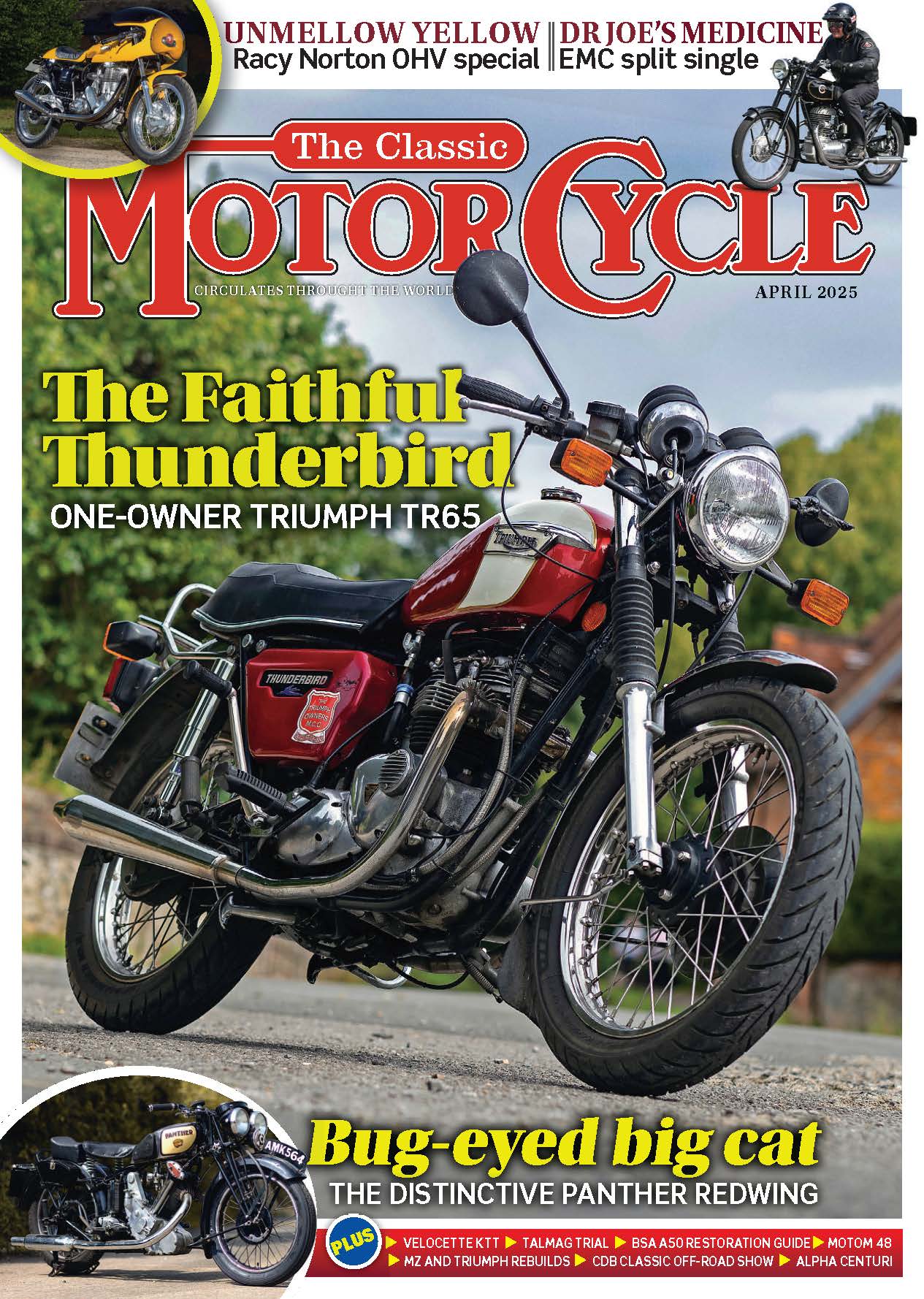Mobile service in the southwest of the UK, offered by Plymouth company Chapman’s, is put to work righting a rear tyre ‘issue.’

Photograph: Mortons Archive
This lovely picture doesn’t appear with much of a story to it, simply captioned: “A travelling workshop catering for motorcyclists in the Plymouth district. These motor vans have been in service for the aid of the car owner for quite a long time, but up to the present, very few garage owners have been sufficiently enterprising to cater specially for stranded motorcyclists.”
Enjoy more Classic MotorCycle reading in the monthly magazine.
Click here to subscribe & save.
Looking closely at the picture – published May 15, 1919 – reveals that it probably isn’t posed, as it seems that there’s an inner tube rather tightly wound around the motorcycle’s rear wheel, which also does the job of hiding its rear hub, although it does still look of big enough dimension to be either a hub gear or clutch, perhaps.
But clues to the motorcycle’s identity are hard to discern; it’s clearly a V-twin, while the fuel tank is a light colour, with darker panels, a thinner line around the whole thing and a centrally mounted petrol tank logo. Initial thought is perhaps a Premier, but on reflection, maybe Rex?
View of the rear exhaust downpipe would have been helpful – as the Rex featured a distinctively angled pipe – as would the silencer but, unfortunately, both are obscured by the man (boy?) attending to the tangled tube. He’s being watched by the chap in uniform, perhaps the senior of the two Chapman’s employees – after all, he has a natty outfit – while what one assumes to be the rider looks rather unconcerned by it all, sitting cross-legged and having a read of the paper, while the drama – well, the tube anyway – unfolds…
The angle of the petrol tank looks rather Rex-esque too, it either being a late pre-First World War model, or an early postwar effort. In fact, the metal toolbox to the rear of the motorcycle’s carrier, all but confirms its Rex identity. Rex was one of the better-known older marques, its first model appearing at the November 1900 show, made in Birmingham, though the firm had relocated to Coventry by 1902. A series of record-breaking runs, including successful ‘end to end’ (Land’s End to John O’Groats) attempts and success in trials, with lady rider Muriel Hind and her famous ‘Blue Devil’ to the fore, meant that the company’s name was a well known one.
Towards the end of 1905, a V-twin engine had been introduced, which featured in the Hind machine. At the other end of the spectrum, Rex was selling his 3½hp single cheaper than most others could manage, while it started – or was at least an early adopter – a trend with a dropped top tube frame, allowing a lower seat height.
By the time our subject picture was taken, Rex was pretty much on its uppers, and, indeed hadn’t actually made any motorcycles since 1916, when the factory was given over to munitions manufacture, though for 1920 motorcycles officiallycame back, with a big 8hp V-twin at the top of the tree. Engine capacities seem to haveeither been 896cc or a bigger version, of 940cc.
In late 1921, Rex amalgamated with Acme, forming Rex-Acme, a company which was to go on to enjoy a good 1920s, winning three TTs, courtesy of star rider, designer and director Wal Handley. After Handley left, circa 1928, the company went into decline and although it struggled on into the 1930s, being bought by sidecar maker Mills-Fulford in 1932, by 1933, the unequal struggle was given up and the company ceased to exist.
What else can we deduce from our picture? Well, the open back doors of the truck mean we’re denied knowing the address – there doesn’t seem to be a ‘Temple Street’ in Plymouth – note how the lowest line of the address ends ‘…PLE STREET’ so we’ll rely on someone with local knowledge to perhaps fill in the gaps.
Badly damaged by bombing during the Second World War, the streets patrolled by Mr Chapman’s van would’ve been rather different to today, owing to significant remodelling necessitated by making good the bomb damage. Plymouth is in Devon, 193 miles south west of London, and a place best known for its maritime history, including being the place where, in 1620, the Pilgrim Fathers, aboard the Mayflower, set sail for the new world, where they established the Plymouth Colony in Massachusetts.
Mr Chapman’s truck would have made the journey from America the other way, being as it’s a Model T Ford. In fact, it would have only been the plans and drawings which had done that journey, as, from 1911, the Model T had been made in Trafford Park, Manchester, which is still a fair way from Plymouth, but nearer than America!
Advert
 Enjoy more The Classic MotorCycle reading in the monthly magazine. Click here to subscribe.
Enjoy more The Classic MotorCycle reading in the monthly magazine. Click here to subscribe.



